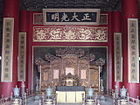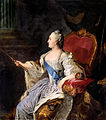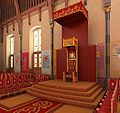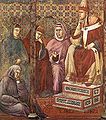- Throne
-
- This article is about royal thrones; for other meanings see Throne (disambiguation).
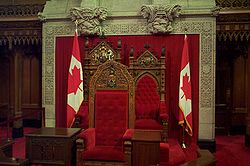 The thrones for Elizabeth II as Queen of Canada, and the Duke of Edinburgh (back) in the Canadian Senate, Ottawa are usually occupied by the Queen's representative, the Governor General and the Governor General's spouse at the Opening of Parliament. The chair in the foreground is for the Speaker of the Senate of Canada.
The thrones for Elizabeth II as Queen of Canada, and the Duke of Edinburgh (back) in the Canadian Senate, Ottawa are usually occupied by the Queen's representative, the Governor General and the Governor General's spouse at the Opening of Parliament. The chair in the foreground is for the Speaker of the Senate of Canada.
A throne is the official chair or seat upon which a monarch is seated on state or ceremonial occasions. "Throne" in an abstract sense can also refer to the monarchy or the Crown itself, an instance of metonymy, and is also used in many expressions such as "the power behind the throne".
Contents
Antiquity
The depiction of monarchs and deities as seated on chairs is a common topos in the iconography of the Ancient Near East.
The word throne itself is from Greek θρόνος (thronos), "seat, chair",[1] in origin a derivation from the PIE root *dher- "to support" (also in dharma "post, sacrificial pole"). Early Greek Διὸς θρόνους (Dios thronous)[2] was a term for the "support of the heavens", i.e. the axis mundi, which term when Zeus became an anthropomorphic god was imagined as the "seat of Zeus".[3] In Ancient Greek, a "thronos" was a specific but ordinary type of chair with a footstool, a high status object but not necessarily with any connotaions of power. The Achaeans (according to Homer) were known to place additional, empty thrones in the royal palaces and temples so that the gods could be seated when they wished to be. The most famous of these thrones was the throne of Apollo in Amyclae.
The Romans also had two types of thrones- one for the Emperor and one for the goddess Roma whose statues were seated upon thrones, which became centers of worship.
Hebrew Bible
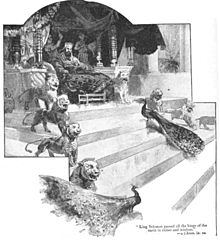 Fanciful depiction of Solomon on his throne
Fanciful depiction of Solomon on his throne
The word "throne" in English translations of the Bible renders Hebrew כסא kissā'. The Pharaoh of the Exodus is described as sitting on a throne (Exodus 11:5, 12:29), but mostly the term refers to the throne of the kingdom of Israel, often called the "throne of David" or "throne of Solomon". The literal throne of Solomon is described in 1 Kings 10:18-20: "Moreover the king made a great throne of ivory, and overlaid it with the best gold.. The throne had six steps, and the top of the throne was round behind: and there were stays on either side on the place of the seat, and two lions stood beside the stays. And twelve lions stood there on the one side and on the other upon the six steps: there was not the like made in any kingdom." In the Book of Esther (5:3), the same word refers to the throne of the king of Persia.
The God of Israel himself is frequently described as sitting on a throne in the Psalms, and in a vision Isaiah (6:1), and notably in Isaiah 66:1, YHWH says of himself "The heaven is my throne, and the earth is my footstool" (this verse is alluded to by Matthew 5:34-35.
Christianity
Main article: CathedraChristian Bible
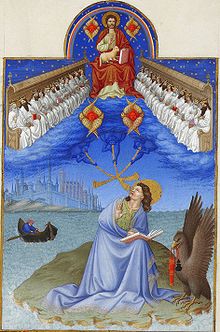 Vision of John of Patmos from the Book of Revelation (4:4)—four seraphim surround the throne of Christ, twenty-four elders sit on thrones to either side (Très Riches Heures du Duc de Berry)
Vision of John of Patmos from the Book of Revelation (4:4)—four seraphim surround the throne of Christ, twenty-four elders sit on thrones to either side (Très Riches Heures du Duc de Berry)
In the New Testament, the angel Gabriel also refers to this throne in the Gospel of Luke (1:32-33): "He will be great, and will be called the Son of the Highest; and the Lord God will give Him the throne of His father David. And He will reign over the house of Jacob forever, and of His kingdom there will be no end."
Jesus promised his Apostles that they would sit upon "twelve thrones", judging the twelve tribes of Israel (Matthew 19:28). John's Revelation states: "And I saw a great white throne, and him that sat on it, from whose face the earth and the heaven fled away" (Revelation 20:11).
The Apostle Paul speaks of "thrones" in Colossians 1:16. Pseudo-Dionysius the Areopagite, in his work, De Coelesti Hierarchia (VI.7) interprets this as referring to one of the ranks of angels (corresponding to the Hebrew Arelim or Ophanim). This concept was expanded upon by Thomas Aquinas in his Summa Theologica (I.108), wherein the thrones are concerned with carrying out divine justice.
In Medieval times the "Throne of Solomon" was associated with the Virgin Mary, who was depicted as the throne upon which Jesus sat. The ivory in the biblical description of the Throne of Solomon was interpreted as representing purity, the gold representing divinity, and the six steps of the throne stood for the six virtues. Psalm 45:9 was also interpreted as referring to the Virgin Mary, the entire Psalm describing a royal throne room.
Ecclesiastical thrones
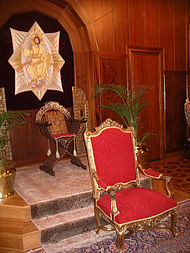 Throne of the Ecumenical Patriarch of Constantinople in the Phanar, Istanbul. On the dais the Gospel is enthroned on a curule chair, in front of it, lower down is the patriarch's throne.
Throne of the Ecumenical Patriarch of Constantinople in the Phanar, Istanbul. On the dais the Gospel is enthroned on a curule chair, in front of it, lower down is the patriarch's throne.
From ancient times, bishops of the Roman Catholic, Eastern Orthodox, Anglican and other churches where episcopal offices exist, have been formally seated on a throne, called a cathedra (Greek: κάθεδρα, seat). Traditionally located in the sanctuary, the cathedra symbolizes the bishop's authority to teach the faith (hence the expression "ex cathedra") and to govern his flock.
"Ex cathedra" refers to the explicative authority, notably the extremely rarely used procedure required for a papal declaration to be 'infallible' under Roman Catholic Canon law. In several languages the word deriving from cathedra is commonly used for an academic teaching mandate, the professorial chair.
From the presence of this cathedra (throne), which can be as elaborate and precious as fits a secular prince (even if the prelate is not a prince of the church in the secular sense), a bishop's primary church is called a cathedral. In the Roman Catholic Church, a basilica -from the Greek basilikos 'royal'-, now refers to the presence there of a papal canopy (ombrellino), part of his regalia, and applies mainly to many cathedrals and Catholic churches of similar importance and/or splendor. In Roman Antiquity a basilica was secular public hall. Thus, the term basilica may also refer to a church designed after the manner of the ancient Roman basilica. Many of the churches built by the emperor Constantine the Great and Justinian are of the basilica style.
Some other prelates besides bishops are permitted the use of thrones, such as abbots and abbesses. These are often simpler than the thrones used by bishops and there may be restrictions on the style and ornamentation used on them, according to the regulations and traditions of the particular denomination.
As a mark of distinction, Roman Catholic bishops and higher prelates have a right to a canopy above their thrones at certain ecclesiastical functions. It is sometimes granted by special privilege to prelates inferior to bishops, but always with limitations as to the days on which it may be used and the character of its ornamentation. The liturgical color of the canopy should correspond with that of the other vestments. When ruling monarchs attend services, they are also allowed to be seated on a throne that is covered by a canopy, but their seats must be outside the sanctuary.[4]
In the Greek Orthodox Church, the bishop's throne will often combine features of the monastic choir stall (kathisma) with appurtenances inherited from the Byzantine court, such as a pair of lions seated at the foot of the throne.
The term "throne" is often used in reference to Patriarchs to designate their ecclesiastical authority; for instance, "the Ecumenical Throne" refers to the authority of the Ecumenical Patriarch of Constantinople.
Western bishops may also use a faldstool to fulfill the liturgical purpose of the cathedra when not in their own cathedral.
Papal Thrones
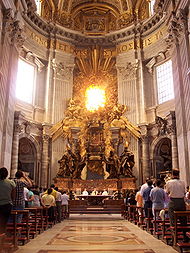 Cathedra Sancti Petri, behind the high altar of St. Peter's Basilica, Rome
Cathedra Sancti Petri, behind the high altar of St. Peter's Basilica, Rome
In the Roman Catholic Church, the Pope is an elected monarch, both under canon law as supreme head of the church, and under international law as the head of state -styled "sovereign pontiff"- of the Vatican City State (the sovereign state located within the city of Rome established by the Lateran Treaty in 1929. Until 1870 the Pope was the elected monarch of the Papal States, which for centuries constituted one of the largest political powers on the divided Italian peninsula). To this day the Holy See maintains officially-recognized diplomatic status, and papal nuncios and legates are deputed on diplomatic missions throughout the world.
The Pope's throne (the Cathedra Romana), is located in the apse of the Basilica of St. John Lateran, his cathedral as Bishop of Rome.
In apse of Saint Peter's Basilica at the Vatican, above the Altar of the Chair lies a throne believed to have been used by St. Peter himself, the Chair of Saint Peter, and that was also used by other earlier Popes; this relic is enclosed in a glit bronze casting and forms part of a huge monument designed by Gian Lorenzo Bernini.
Unlike the Papal Cathedral of St. John Lateran, there is no permanent cathedra for the Pope in St. Peter's basilica, so a removable throne is placed in the St. Peter's basilica for the Pope's use whenever a liturgical ceremony presided by him takes place. Prior to the liturgical reforms that occurred in the wake of the Second Vatican Council, a huge removable throne, with a canopy, was placed above an also removable dais in the choir side of the Altar of the Confession (the basilica's High Altar, above the tomb of St. Peter and beneath the monumental bronze baldachinno); this throne stood between the apse of the basilica (where the Altar of the Chair and the Cathedra Petri monument are) and the Altar of the Confession.
After the reform of Papal liturgy that happeened in the late 1960s and early 1970s, this practice has fallen out of use, and, whenever the Pope celebrates Mass in St. Peter's basilica, a simpler portable throne is now placed in front of the Altar of the Confession, over a platform. Since the pontificate of Benedict XVI, however, when the Pope celebrates the Liturgy of the Hours at the basilica, a more ellaborate removable Throne over a dais is placed to the side of the Altar of the Chair. Whenever the Pope celebrates Mass on the steps of the Basilica, facing St. Peter's square, portable thrones are also used.
In the past, the pope was also carried on occasions in a portable throne, called the sedia gestatoria. Originally, the sedia was used as part of the elaborate procession surrounding papal ceremonies that was believed to be the most direct heir of pharaonic splendor, and included a pair of flabella (fans made from ostrich feathers) to either side. Pope John Paul I at first abandoned the use of these implements, but later in his brief reign began to use the sedia so that he could be seen more easily by the crowds. However, he did not restore the use of the flabella. The use of the sedia was abandoned by Pope John Paul II in favor of the so-called "popemobile" when outside. Near the end of his pontificate, Pope John Paul II had a specially-constructed throne on wheels that could be used inside.
Prior to 1978, at the Papal conclave, each cardinal was seated on a throne in the Sistine Chapel during the balloting. Each throne had a canopy over it. After a successful election, once the new pope accepted election and decided by what name he would be known, the cardinals would all lower their canopies, leaving only the canopy over the newly-elected pope. This was the new pope's first throne. This tradition was dramatically portrayed in the 1963 film, The Shoes of the Fisherman.
Middle Ages
 Throne of German kings at Aachen Cathedral
Throne of German kings at Aachen Cathedral
In European feudal countries, monarchs often were seated on thrones, based in all likelihood on the Roman magisterial chair. These thrones were originally quite simple, especially when compared to their Asian counterparts. One of the grandest and most important was the Throne of Ivan "the Terrible". Dating from the mid-16th century, it is shaped as a high-backed chair with arm rests, and adorned with ivory and walrus bone plaques intricately carved with mythological, heraldic and life scenes. The plaques carved with scenes from the biblical account of King David’s life are of particular relevance, as David was seen as the ideal for Christian monarchs.[5]
The throne of the Byzantine Empire included elaborate automatons of singing birds.[6]
In the Indian subcontinent, the term gaddi (Hindustani pronunciation: [ˈɡəd̪d̪i], also called rājgaddī) was reserved for the throne of a Hindu princely state's ruler, while their Muslim colleagues throned on a musnad ([ˈməsnəd]), even though both were in the shape of a divan. In the Mughal times the throne was called Shāhī takht ([ˈʃaːhiː ˈtəxt]), while traditional Sanskrit name for the throne was singhāsana (lit., seat of a lion).
In the 'regency' (nominally an Ottoman province, de facto an independent realm) of the Bey of Tunis, the throne was called kursi.
Modern period
During the Russian Empire, the throne in St. George's Hall (the "Greater Throne Room") in the Winter Palace was regarded as the throne of Russia. It sits atop a seven-stepped dais with a proscenium arch above and the symbol of the Imperial Family behind (the two-headed eagle). Peter I's Room (the "Smaller Throne Room") is modest in comparison to the former. The throne was made for Empress Anna Ivanovna in London. There is also a throne in the Grand Throne Room of the Peterhof Palace.
In some countries which retain a monarchy, thrones are still used and have important symbolic and ceremonial meaning. Among the most famous thrones still in usage are St Edward's Chair, on which the British monarch is crowned, and the thrones used by monarchs during the state opening of parliaments in the United Kingdom, the Netherlands, Canada, Australia, and Japan (see above) among others.
Some republics use distinctive throne-like chairs in some state ceremonial. The President of Ireland sits on a former viceregal throne during his or her inauguration ceremony while Lords Mayor of many British and Irish cities often preside over local councils from throne-like chairs.
List of named thrones
- The Throne of Solomon
Europe
- The Throne of Apollo in Amyclae
- St. Edward's Chair in Westminster Abbey, London, where British monarchs are crowned. It at one time contained the Stone of Scone (also called the Stone of Destiny) upon which the Kings of Scotland were crowned
- The Throne of Charlemagne in the cathedral at Aachen, Germany
- The Imperial Throne of the medieval German kings and emperors in Goslar, Germany.
- The Ivory Throne of Ivan the Terrible
- The papal sedia gestatoria
- Queen Christina's Silver Throne in the Royal Palace, Stockholm, Sweden.
Africa
- the Golden Stool of the Ashanti
- the Throne of David of the Emperors of Ethiopia
Asia
- Dragon Throne of the Emperors of China
- Chrysanthemum Throne of the Emperors of Japan
- the Phoenix Throne of the Kings of Korea
- the Lion Throne of the Dalai Lama of Tibet
- the Lion Throne of Sikkim
- the stone throne of King Kasyapa from SriLanka [1] from the 5th century citadel of Sigiri
- the stone throne of King Nissankamalla from Sri Lanka [2] from the 12th century Polonnaruwa kingdom
- the Kandian Throne of the Kingdom of Kandy and the Dominion of Ceylon
- the Peacock Throne of the Mughal Emperors, later became:
- the Peacock Throne of the Persian Shahs
- the Takht-e Marmar of the Persian Shahs
- the Peacock Throne of Korea
- the Peacock throne at Montchobo, then at Ava, ancient capitals of Burma
- the Saridhaleys 'ivory throne' and the sighsana 'lion throne' of the Maldives sultanate
- the sandalwood throne, at Bikaner Fort
- Maharaja Ranjit Singh's throne
Gallery
Thrones of kings and emperors
-
Imperial throne of Napoleon
-
Throne of the Emperor of Brazil, Pedro I
-
Throne of Polish King Stanisław August Poniatowski at Warsaw Royal Castle
-
Throne of the monarch of the Netherlands in the Ridderzaal
Thrones of the popes
-
Throne of Pope Honorius III.
-
Throne of Pope Pius II. (Enea Silvio Piccolomini)
Other uses
- In music, the stool used to sit behind a drum kit is often called a throne.
- In religion, a niche in an altar piece for displaying the Holy Sacrament is called a throne.
- In slang, a common sit-down toilet is also called a throne.
- One of the Angel choirs is an order called Ophanim or 'Thrones', said to carry God's heavenly throne - other choir names expressing power in secular terms include Powers, Principalities, Dominions
Sources and references
- ^ θρόνος, Henry George Liddell, Robert Scott, A Greek-English Lexicon, on Perseus
- ^ Sophocles, Antigone, 1041, on Perseus
- ^ Janda, Michael, Die Musik nach dem Chaos, Innsbruck 2010.
- ^ "Canopy". The Catholic Encyclopedia. III. New York: Robert Appleton Company. 1908. http://www.newadvent.org/cathen/03297c.htm. Retrieved 2007-07-12.
- ^ "Throne of Ivan IV the Terrible". Regalia of Russian Tsars. The Moscow Kremlin. http://www.kreml.ru/en/main/virtual/exposition/regalia/IvanIV/throne/. Retrieved 2007-07-12.
- ^ Brett, Gerard (1954-07). "The Automata in the Byzantine "Throne of Solomon"". Speculum 29 (3): 477–487. doi:10.2307/2846790. ISSN 00387134. JSTOR 2846790.
See also
External links
Wikimedia Foundation. 2010.


